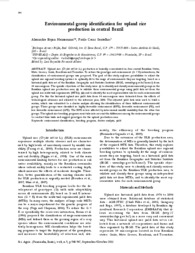Environmental group identification for upland rice production in central Brazil.
Environmental group identification for upland rice production in central Brazil.
Autoria: HEINEMANN, A. B.; SENTELHAS, P. C.
Resumo: Upland rice (Oryza sativa L.) production is basically concentrated in four central Brazilian States, Mato Grosso, Goiás, Rondônia and Tocantins. To reduce the genotype and environment (G × E) interactions, the classification of environment groups was proposed. The goal of this study explores possibilities to adjust the upland rice regional breeding systems to optimally fit to the range of environments they are targeting, based on a historical yield data set of the Brazilian Geographic and Statistics Institute (IBGE, http://www.ibge.gov.br/home/) from 54 microregions. The specific objectives of this study were: (i) to identify and classify environmental groups in the Brazilian upland rice production area; (ii) to validate these environmental groups using yield data set from the upland rice multi-trial experiments (MTEs); (iii) and to identify the most representative site for each environmental group. For this the historical upland rice yield data from 54 microregions were detrented from the effects of technological advances and adjusted to the reference year, 2006. The adjusted yield data were used to build a matrix, which was submitted to a cluster analysis allowing the identification of three different environmental groups. These groups were classified as: highly favorable environment (HFE); favorable environment (FE); and less favorable environment (LFE). The HFE is less affected by inter-annual rainfall variability than the other two groups. The upland rice breeding programs must take into account the differences among the environmental groups to conduct their trials and suggest genotypes for the upland production area.
Ano de publicação: 2011
Tipo de publicação: Artigo de periódico
Unidade: Embrapa Arroz e Feijão
Palavras-chave: Análise estatística, Arroz, Breading program, Cluster analysis, Environment classification, Oryza sativa, Yields
Observações
1 - Por padrão são exibidas publicações dos últimos 20 anos. Para encontrar publicações mais antigas, configure o filtro ano de publicação, colocando o ano a partir do qual você deseja encontrar publicações. O filtro está na coluna da esquerda na busca acima.
2 - Para ler algumas publicações da Embrapa (apenas as que estão em formato ePub), é necessário ter, no celular ou computador, um desses softwares gratuitos. Sistemas Android: Google Play Livros; IOS: iBooks; Windows e Linux: software Calibre.
Acesse outras publicações
Acesse a Base de Dados da Pesquisa Agropecuária (BDPA) para consultar o acervo completo das bibliotecas da Embrapa.

